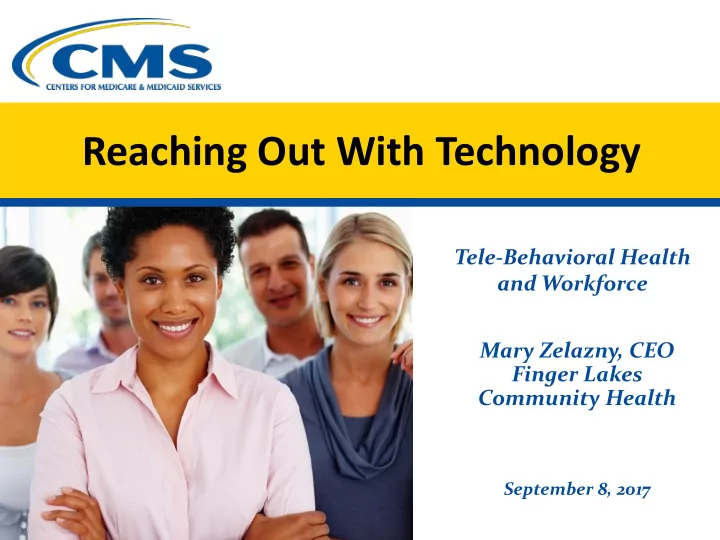

Reaching Out With Technology Tele-Behavioral Health and Workforce Mary Zelazny, CEO Finger Lakes Community Health September 8, 2017
Why Tele-Behavioral Health? • Access to providers – overcoming geographical barriers • Linkage of physical and behavioral health providers • Reduction of stigma • Educational opportunities for clinicians in the primary care setting • Data is demonstrating that telehealth can help meet the triple aim
Telehealth Reimbursement • Reimbursement issues are most common reason healthcare organizations give for not adopting telehealth • Very complicated reimbursement policies - every state has a different telehealth policy • Medicare has challenges with its telehealth policies (rural vs urban) • Medicaid reimbursement varies by state and some MCO’s are challenging the need to reimburse for “virtual visits” The good news: There is a lot of movement to figure this out at all levels. 3
Cost Benefit Analysis For Patients/Community: Decreased : *transportation issues/costs *lost work/unpaid time *Emergency Dept. visits *time to treatment Increased : *Continuity of care *Access to behavioral health services *Simultaneous communicate with PCP and Specialist *Access to Language Services via video * High patient satisfaction! 4
Cost Benefit Analysis For Providers: *Providers can cover multiple sites by offering services via telehealth technologies *Ability to participate in patient consults with specialist, learning additional skills *Providers are able to develop relationships with the specialists they are referring their patients to, allowing for more interaction *Peer to peer learning opportunities through case conferencing (Project Echo) *Precepting of providers via video
Models That Work – TelePeds Neurology Tele-Peds Neurology: • Decreased time to treatment – was 60+ days, now averages 12-21 days • 75% of patients had changes/additions to their med regimens. • 87.5% diagnosed with mental health co-morbidity • 63% showed improvement in function at school and home • Our clinicians are now able to treat more patients in the primary care setting, referring only more difficult cases to specialty care via telehealth Great collaboration between patient, care giver, primary care provider and Peds Neuro Specialist! 6
Models That Work – TelePsych • We contract with 2 psychiatry programs to meet the needs of our patients (both offer multiple language access) • Our mental health counselors are able to “huddle” with both the psychiatrist and patient together to ensure understanding • 55% of patients had a decrease in PHQ9 scores • Mean time to consult with Psychiatrist – 19 days • Mean time to treatment – within 24 hour • 17% of patients seen by Psychiatrist via video were referred for more intensive treatment within the community • The risk of stigma is reduced as the patient doesn’t have to travel to the “mental health clinic” for care. Our clinical staff have a much better understanding of behavioral health diagnoses and treatment due to consistent communications with specialists. Many more appropriate referrals are being made. 7
Workforce Expansion • We have used telehealth technologies to expand the reach of our current providers to cover more sites. • For behavioral health visits, many of our patients have stated that they prefer seeing their counselor/psychiatrist via video • We have embedded our partner substance use counselors into our sites via video • Our MD’s can attend patient consults via video to assist our midlevel providers with challenging cases Care management, coupled with telehealth has been a real game-changer for our patient outcomes
Telehealth – Meeting the Triple Aim • This technology has demonstrated that its use can lower the utilization of acute care settings by keeping patients in the primary care setting, thus lowering the cost of care • The quality of the care that patients are receiving is better as it is offered by a “team” of providers in a timely manner, having full access to data and information • This type of innovation has the ability to improve patient experiences through convenience, access to more providers, and collaboration between primary care and specialty care.
Thank You! Mary Zelazny, CEO Finger Lakes Community Health PO Box 423 Penn Yan, NY 14527 315.531.9102 maryz@flchealth.org www.localcommunityhealth.org
Recommend
More recommend